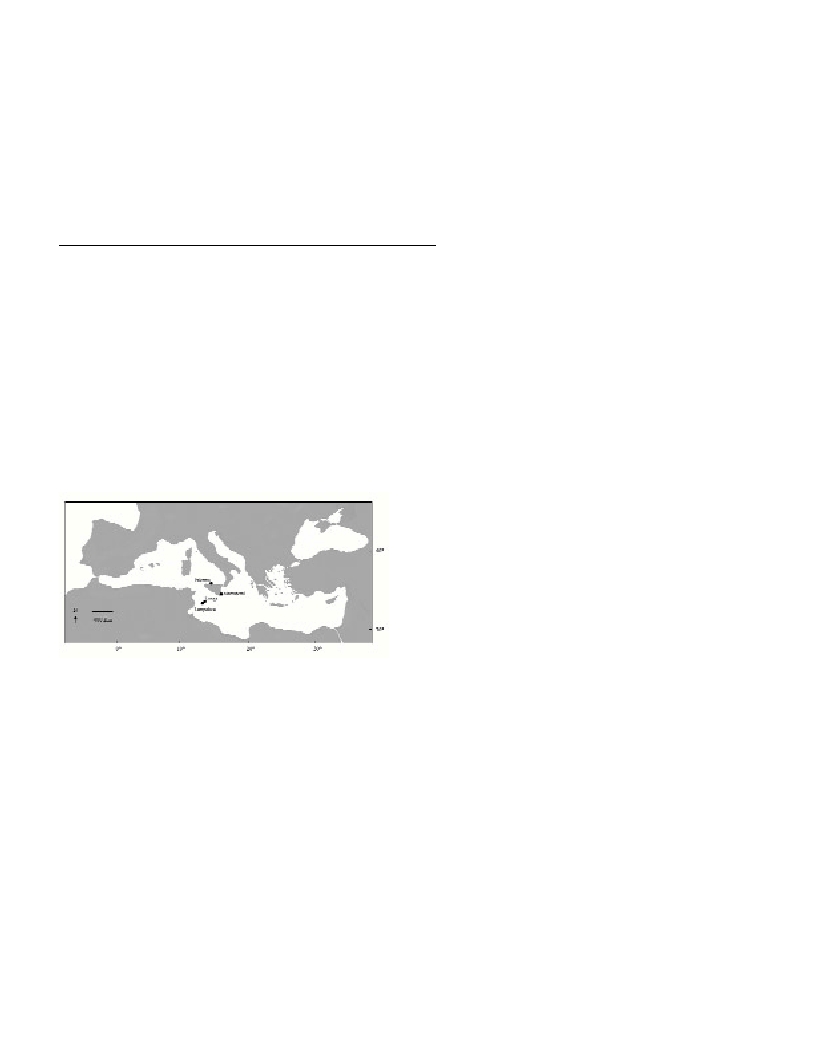NOTES ON THE BIOLOGY OF PERCNON GIBBESI (BRACHYURA, GRAPSIDAE)
IN THE CENTRAL MEDITERRANEAN SEA
Fanelli E.
1
, Azzurro E.
2 *
1
Istitut de Ciencies del Mar, 003 Barcelona, Spain - efanelli@cmima.csic.es
2
Istituto di Scienze del Mare, Università di Ancona, Italy
Abstract
The ?at rock crab Percnon gibbesi, found for the first time in 1999 in Linosa (Pelagie Islands-Italy), was expanded in southern and western
Mediterranean. This study focused on some aspects of its biology in order to investigate the causes of its rapid spreading. Crabs examined
were collected during August 2003 in 4 different sites in the Central Mediterranean (Linosa, Lampedusa, Palermo and Marzanemi, Sicily-
Italy). Carapace length sex and ovigerous condition were determined. Some differences were evidenced between the samples collected on
natural and artificial rocks.
Key words: biology, reproduction, Percnon gibbesi, Central Mediterranean
Rapp. Comm. int. Mer Médit., 37,2004
519
Introduction
Percon gibbesi (H. Milne Edwards, 1853)is an alien species,
recorded for the first time in the central Mediterranean sea in 1999 (1).
Since now several records of this species were marked in different
areas of the Mediterranean sea (2,3,4) together with several oral
communication (www.ciesm.org/atlas/), demonstrating the rapid
spreading of this species. Some preliminary studies were focused on
reproduction (5) and feeding (6), but despite its large abundance in the
southern coasts of Italy (Sicily and Pelagie islands) many aspects of
its biology and ecology are still unknown. The aim of this study is to
contribute to the knowledge of some biological aspects of this exotic
species.
Material and Methods
A total of 229 specimens of Percnon gibbesi were collected in the
southern coast of Italy (see Fig. 1) in August 2003, from 0 to 3 m of
depth.
All the samples were measured in mm (carapace length CL with the
accuracy of 0.1 mm). Normality of the length data was determined
using the Kolmogorov–Smirnov test prior to comparing the
differences between samples collected on natural (specimens
collected in Linosa) and artificial rocks (specimens from Lampedusa,
Palermo and Marzanemi). To estimate fecundity, eggs from 20
recently spawned females were manually removed from the pleopods
and then the procedure suggested by Abello (7) was followed. Sex-
ratios by 1 mm size classes were determined and tested by a chi-
square analysis.
Results and Discussion
The length frequency distribution of the whole sample, grouped in
1 mm, showed that CL ranges between 11 mm and 38 mm and the
distribution is plurimodal. Three modes are recognisable peaking at
CL ranges of 11-18 mm, 19-28 mm, and 29-38 mm. Linosa
population was mainly formed by smaller animals (CL: 11-28 mm),
while Lampedusa, Palermo and Marzanemi populations were chie?y
composed by medium and large size specimens (CL: 14-38 mm). This
can be probably due to the wider crevices offered by the artificial reefs
to larger individuals, comparing to natural rocks, that give a more
suitable protection to the smaller specimens. The normalized
distributions of natural rocks and artificial rocks samples (natural
rocks K-S d=0,22278, p<0,10 ; Lilliefors p<0,01; artificial rocks: K-S
d=0,18037, p> 0,20; Lilliefors p<0,05) resulted different.
Of a total of 229 individuals, 123 (53.7%) were males and 106
(46.3%) females with a sex-ratio of 1:0.86. Males are bigger than
females and the maximum size recorded in this study overreaches the
values referred by Manning and Holthuis (8) (a male measuring
38,2mm CL and 39,9 mm CW). The smallest females carrying eggs
had a 14 mm CL, FMS for August resulted 13,4 mm CL. In the
sampling period 92% of studied females carried eggs in different
development stages. The brood size of these females ranged from 38
(the smallest female carrying eggs) to 11.881 eggs.
Some hypothesis may be formulated in order to explain the rapid
spreading:
1)P. gibbesicould have occupied an empty niche;
2)Its apparent long reproductive period, as reported by Puccio et
al.(3), together with a low FMS as reported in this study;
3)Its feeding habits, mainly focused on algae and coralline algae
(4), abundant and no competitive resources in its living habitat.
Further biological and ecological studies are necessary to
understand the role of this species in the coastal ecosystem and the
potential implications in the Mediterranean trophic webs.
References
1-Relini M., L. Orsi, V. Puccio and E. Azzurro, 2000. The exotic crab
Percnon gibbesi(H. Milne Edwards, 1853) (Decapoda, Grapsidae) in the
Central Mediterranean. Scientia Marina, 64(3): 337-340.
2-Garcia L. and B. Reviriego, 2000. Presència del cranc subtropical
Percnon gibbesi(H. Milne Edwards, 1853) (Crustacea, Decapoda,
Grapsidae) a les Illes Balears. Primera cita a la Mediterrània occidental.
Bolleti de la Societat d’Història natural de les Balears, 43: 81-89.
3-Mueller C. First record of Percnon gibbesi (Crustacea: Decapoda:
Grapsidae) for the Balearic Islands, 2001. Senckenb. Marit. 31(1): 83-89.
4-Pipitone C., Badalamenti F., Sparrow A., 2001. Contribution to the
knowledge of Percnon gibbesi(Decapoda, Grapsidae), an exotic species
spreading rapidly in Sicilian waters. Crustaceana74(10): 1009-1017.
5-Puccio V., Relini M., Azzurro E. 2002. Osservazioni sulla riproduzione
di Percnon gibbesi(H. Milne Edwards, 1853) a Linosa. Symposium
SIBM, Castelsardo, Italy: 3-8 June 2002.
6-Puccio V., Relini M., Azzurro E., Relini L.O., 2002. Feeding habits of
Percnon gibbesi(H. Milne Edwards, 1853) in the Sicily strait. VIII
Colloquium on Crustacea Decapoda. Corfù, Greece: 2-6 September 2002.
7-Abellò P. 1989. Reproducyion and moulting in Liocarcinus depurator
(Linnaeus, 1758) (Brachyura: Portunidae) in the Northwestern
Mediterranean sea. Scientia Marina, 53(1): 127-134.
8-Manning R.B., Holthuis L.B., 1981. West African Brachyuran Crabs
(Crustacea: Decapoda). Smithsonian Contribution to Zoology, 306, 379 p.
Fig. 1. Sampling sites.

